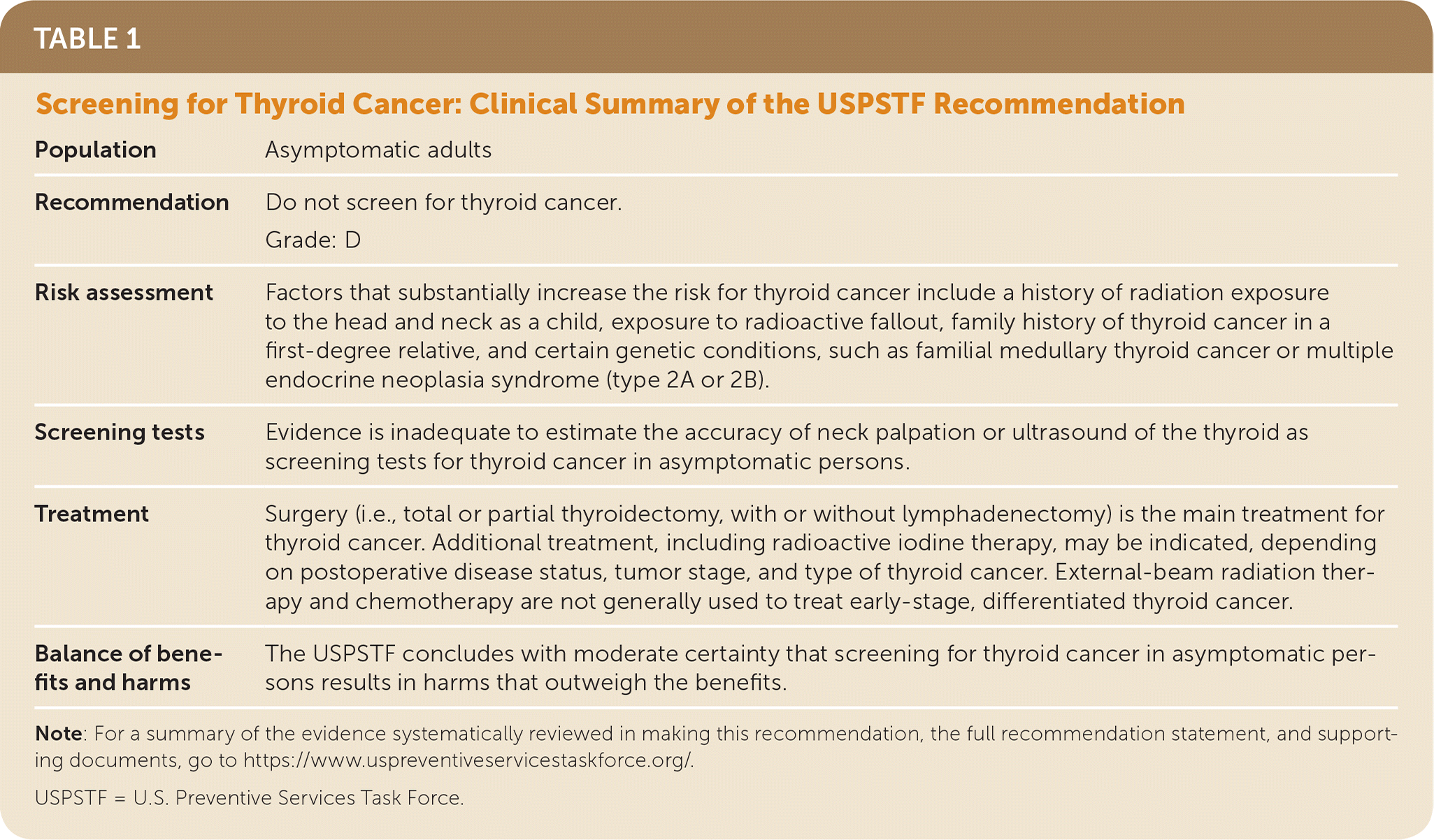
Am Fam Physician. 2018;97(6):online
Related Putting Prevention into Practice: Screening for Thyroid Cancer
As published by the U.S. Preventive Services Task Force.
Summary of Recommendation and Evidence
The USPSTF recommends against screening for thyroid cancer in asymptomatic adults (Table 1). D recommendation.

| Population | Asymptomatic adults |
| Recommendation | Do not screen for thyroid cancer. Grade: D |
| Risk assessment | Factors that substantially increase the risk for thyroid cancer include a history of radiation exposure to the head and neck as a child, exposure to radioactive fallout, family history of thyroid cancer in a first-degree relative, and certain genetic conditions, such as familial medullary thyroid cancer or multiple endocrine neoplasia syndrome (type 2A or 2B). |
| Screening tests | Evidence is inadequate to estimate the accuracy of neck palpation or ultrasound of the thyroid as screening tests for thyroid cancer in asymptomatic persons. |
| Treatment | Surgery (i.e., total or partial thyroidectomy, with or without lymphadenectomy) is the main treatment for thyroid cancer. Additional treatment, including radioactive iodine therapy, may be indicated, depending on postoperative disease status, tumor stage, and type of thyroid cancer. External-beam radiation therapy and chemotherapy are not generally used to treat early-stage, differentiated thyroid cancer. |
| Balance of benefits and harms | The USPSTF concludes with moderate certainty that screening for thyroid cancer in asymptomatic persons results in harms that outweigh the benefits. |
Rationale
IMPORTANCE
In 2013, the incidence rate of thyroid cancer in the United States was 15.3 cases per 100,000 persons, which is a significant increase from 1975, when the incidence rate was 4.9 cases per 100,000 persons.1 The increase was 6.7% per year from 1997 to 2009, but the rate of increase has slowed to 2.1% per year in recent years (2009–2013).1 Meanwhile, the change in mortality rate has increased by only about 0.7 deaths per 100,000 persons each year.1 Most cases of thyroid cancer have a good prognosis.2 The 5-year survival rate for thyroid cancer overall is 98.1% and varies from 99.9% for localized disease to 55.3% for distant disease.3
DETECTION
The USPSTF found inadequate evidence to estimate the accuracy of neck palpation or ultrasound as a screening test for thyroid cancer in asymptomatic persons.
BENEFITS OF EARLY DETECTION AND TREATMENT
The USPSTF found inadequate direct evidence to determine whether screening for thyroid cancer in asymptomatic persons using neck palpation or ultrasound improves health outcomes. However, the USPSTF determined that the magnitude of benefit can be bounded as no greater than small, based on the relative rarity of thyroid cancer, the apparent lack of difference in outcomes between patients who are treated vs. only monitored (i.e., for the most common tumor types), and the observational evidence demonstrating no change in mortality over time after introduction of a population-based screening program.
HARMS OF EARLY DETECTION AND TREATMENT
The USPSTF found inadequate direct evidence to assess the harms of screening for thyroid cancer in asymptomatic persons. The USPSTF found adequate evidence to bound the magnitude of the overall harms of screening and treatment as at least moderate, based on adequate evidence of serious harms of treatment of thyroid cancer and evidence that overdiagnosis and overtreatment are likely consequences of screening.
USPSTF ASSESSMENT
The USPSTF concludes with moderate certainty that screening for thyroid cancer in asymptomatic persons results in harms that outweigh the benefits.
Clinical Considerations
PATIENT POPULATION UNDER CONSIDERATION
This recommendation applies to screening in asymptomatic adults. It does not apply to persons who experience hoarseness, pain, difficulty swallowing, or other throat symptoms or persons who have lumps, swelling, asymmetry of the neck, or other reasons for a neck examination. It also does not apply to persons at increased risk of thyroid cancer because of a history of exposure to ionizing radiation (e.g., medical treatment or radiation fallout), particularly persons with a diet low in iodine, an inherited genetic syndrome associated with thyroid cancer (e.g., familial adenomatous polyposis), or a first-degree relative with a history of thyroid cancer.4,5
ASSESSMENT OF RISK
Although the USPSTF recommends against screening in the general asymptomatic adult population, several factors substantially increase the risk for thyroid cancer, including a history of radiation exposure to the head and neck as a child, exposure to radioactive fallout, family history of thyroid cancer in a first-degree relative, and certain genetic conditions, such as familial medullary thyroid cancer or multiple endocrine neoplasia syndrome (type 2A or 2B).4
SCREENING TESTS
Although screening for thyroid cancer using neck palpation and ultrasound of the thyroid has been studied, the USPSTF recommends against screening in the general asymptomatic adult population.
TREATMENT AND INTERVENTIONS
Surgery (i.e., total or partial thyroidectomy, with or without lymphadenectomy) is the main treatment of thyroid cancer. Additional treatment, including radioactive iodine therapy, may be indicated, depending on postoperative disease status, tumor stage, and type of thyroid cancer. External-beam radiation therapy and chemotherapy are not generally used to treat early-stage, differentiated thyroid cancer.
